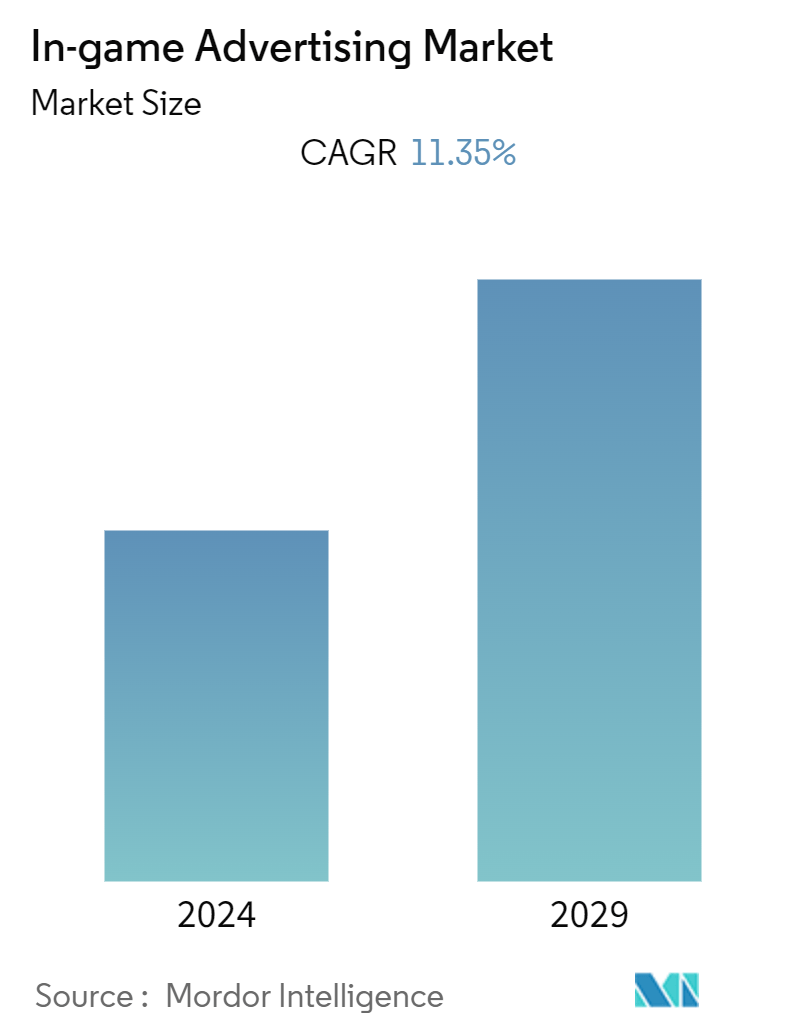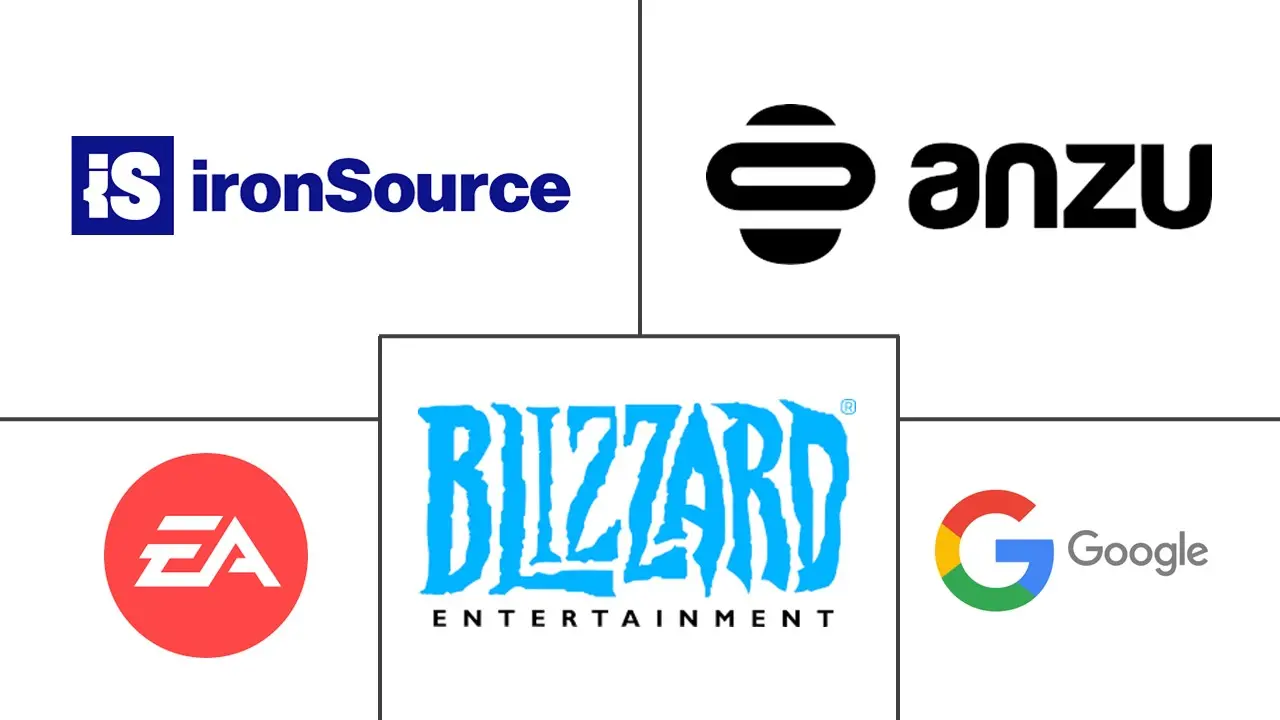Market Size of In-game Advertising Industry

| Study Period | 2019 - 2029 |
| Base Year For Estimation | 2023 |
| CAGR (2024 - 2029) | 11.35 % |
| Fastest Growing Market | Asia Pacific |
| Largest Market | North America |
| Market Concentration | Medium |
Major Players
*Disclaimer: Major Players sorted in no particular order |
In-game Advertising Market Analysis
The In-game Advertising Market is expected to register a CAGR of 11.35% during the forecast period.
In-game advertising market growth is anticipated to benefit from rising social and mobile gaming interest. Commercials, billboards, and backdrop graphics may be used in desktop and mobile games, including advertising. Additionally, because these ads aren't disruptive, gamers may experience the game more seamlessly. In-game commercials are anticipated to have a more substantial audio-visual impact and leave viewers with positive and enduring product impressions.
- Real-time bidding (RTB) and artificial intelligence (AI) are utilized to place these advertisements in online games. Previously, agents were responsible for purchasing and dealing with in-game promotions, which could be costly. However, programmatic advertisement buying has made the process more efficient and cost-effective by eliminating mortal involvement. In the traditional method, advertisers had to go through proposals, quotes, tenders, and negotiations with humans to purchase in-game advertisements. Conversely, programmatic in-game advertisement buying employs algorithms to acquire display space.
- Due to technological advances, digital advertising presentations can now connect to consumers' mobile devices, shifting them to companies' social media accounts or websites. Static advertising can also incorporate augmented reality for interactivity, attracting businesses to use these technologies in outdoor advertisements to increase awareness. In a London campaign, an augmented reality application connected to a digital screen showed a picture of a sick patient and an empty blood pack. Visual recognition activated potential donors with a needle and tube on their mobile screens, showing virtual blood flow and the patient visibly enhancing. These features make advertising attractive, contributing to the growth of the global in-game advertising market.
- People's increasing interest in social media, mobile gaming, and online casual gaming is predicted to drive the growth of the advertising segment in the global online casual games market over the forecast years. Furthermore, essential industry players' strategic acquisitions and business expansions are expected to enhance segment growth. In May 2022, WPP and Epic Games, the interactive entertainment firm developer of Fortnite and Unreal Engine, announced a new partnership to assist WPP agencies in delivering a new era of digital experiences for brands in the metaverse. A new training program will be launched to teach thousands of WPP creatives and engineers how to develop personalized brand experiences in Fortnite and use Unreal Engine for real-time 3D creation and virtual production.
- On the flip side, the placement of advertisements is a crucial aspect of in-game advertising, as it must align with the game's flow and context. It is essential for advertising companies to strategically place advertisements in a manner that appears natural to gamers and delivers exclusivity to advertisers. Unfortunately, some advertising companies fail to do so, showing disruptions in the gaming experience and adverse effects on advertisers' brands. For example, displaying sports-related ads in food-themed games would be an inappropriate placement.
In-game Advertising Industry Segmentation
In-game advertising is the phrase used to describe any state of advertising in a Video Game. In-game advertising can be a very compelling form of marketing as gamers are typically young and spend a lot of time recreating video games. In addition, the nature of video games means that in-game ads have to compete with only other elements within the game for attention from players.
The in-game advertising market is segmented by type (static, dynamic, advergaming) and by geography (North America, Europe, Asia Pacific, Latin America, Middle East, and Africa).
The market sizes and forecasts are provided in terms of value USD for all the above segments.
| By Type | |
| Static | |
| Dynamic | |
| Advergaming |
| By Geography*** | |||||||
| |||||||
| |||||||
| |||||||
| Middle East and Africa | |||||||
| Latin America |
In-game Advertising Market Size Summary
The in-game advertising market is poised for significant growth, driven by the increasing popularity of social and mobile gaming. This growth is facilitated by the integration of non-disruptive advertisements such as commercials, billboards, and backdrop graphics within games, enhancing the gaming experience without interruption. The use of real-time bidding and artificial intelligence has streamlined the process of placing these ads, making it more efficient and cost-effective compared to traditional methods. Technological advancements have also enabled digital advertisements to connect with consumers' mobile devices, incorporating features like augmented reality to boost interactivity and engagement. This evolution in advertising strategies is attracting businesses to leverage these technologies, thereby expanding the global in-game advertising market.
The market's expansion is further supported by the increasing number of gamers and the rise of mobile gaming, particularly in regions like North America and Asia. Strategic partnerships and collaborations among key industry players, such as those between WPP and Epic Games, and Frameplay and Gamestack, are enhancing the market's growth by facilitating the development of personalized brand experiences in gaming environments. However, the effectiveness of in-game advertising relies heavily on the strategic placement of ads to maintain the game's flow and context. Despite challenges, the market continues to thrive, with significant investments and innovations driving its trajectory forward.
In-game Advertising Market Size - Table of Contents
-
1. MARKET INSIGHTS
-
1.1 Market Overview
-
1.2 Industry Attractiveness - Porter's Five Forces Analysis
-
1.2.1 Bargaining Power of Buyers
-
1.2.2 Bargaining Power of Suppliers
-
1.2.3 Threat of New Entrants
-
1.2.4 Threat of Substitutes
-
1.2.5 Intensity of Competitive Rivalry
-
-
1.3 Assessment of the Impact of COVID-19 on the Market
-
-
2. MARKET SEGMENTATION
-
2.1 By Type
-
2.1.1 Static
-
2.1.2 Dynamic
-
2.1.3 Advergaming
-
-
2.2 By Geography***
-
2.2.1 North America
-
2.2.1.1 United States
-
2.2.1.2 Canada
-
-
2.2.2 Europe
-
2.2.2.1 United Kingdom
-
2.2.2.2 Germany
-
2.2.2.3 France
-
-
2.2.3 Asia
-
2.2.3.1 China
-
2.2.3.2 Japan
-
2.2.3.3 India
-
2.2.3.4 South Korea
-
2.2.3.5 Australia and New Zealand
-
-
2.2.4 Middle East and Africa
-
2.2.5 Latin America
-
-
In-game Advertising Market Size FAQs
What is the current In-game Advertising Market size?
The In-game Advertising Market is projected to register a CAGR of 11.35% during the forecast period (2024-2029)
Who are the key players in In-game Advertising Market?
Google LLC, Anzu Virtual Reality Ltd., Blizzard Entertainment Inc., Electronic Arts Inc. and IronSource Ltd. are the major companies operating in the In-game Advertising Market.

